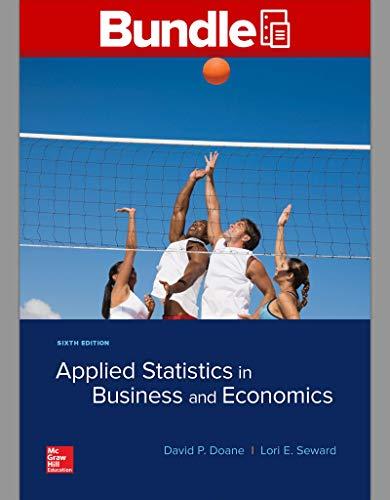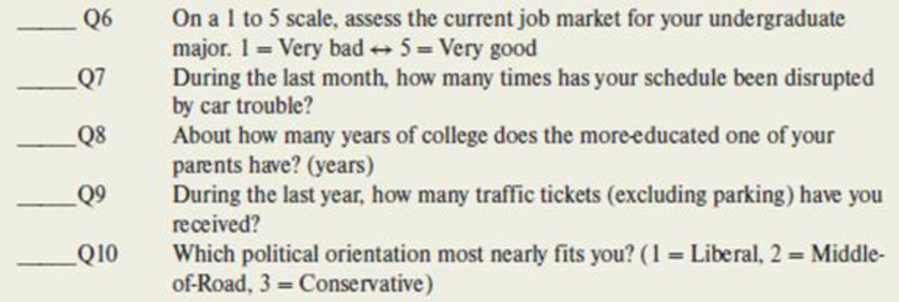
Below are five questions from a survey of MBA students Answers were written in the blank at the left of each question. For each question, state the data type (categorical, discrete numerical, or continuous numerical) and measurement level (nominal, ordinal, interval, ratio). Explain your reasoning. If there is doubt discuss the alternatives.

a.
Identify the data type as categorical, discrete numerical or continuous numerical and the measurement level as nominal, ordinal, interval or ratio for the given question.
Answer to Problem 34CE
The data type of the question “On a 1 to 5 scale, assess the current job market for your undergraduate major.” is categorical.
The question has ordinal measurement level.
Explanation of Solution
A survey is conducted on MBA students. The given question is, “On a 1 to 5 scale, assess the current job market for your undergraduate major. 1 = Very bad
Categorical data:
The type of data that naturally take non-numerical values, such as words that can classify or name the data points based on their quality, are called qualitative or categorical data. In order to facilitate the use of statistical methods on categorical data, a commonly used process used is coding, where each value of the categorical variable is coded or represented using a unique number.
Discrete numerical data:
The type of data that can take a countable number of distinct numerical or quantitative values is called a discrete numerical data.
Continuous numerical data:
The type of data that can take an uncountable or infinite number of numerical or quantitative values within any given interval is called a continuous numerical data.
The perception of an MBA student regarding the job market for their undergraduate major simply classifies or categorizes the parent. It does not take any numerical values naturally. Even if there are numerical values, mathematical operations cannot be applied on such values.
Hence, the data type of the question “On a 1 to 5 scale, assess the current job market for your undergraduate major.” is categorical.
Nominal measurement:
Nominal measurement is the most basic form of measurement that names or categorizes or classifies data. It is the weakest and easiest form of measurement.
Ordinal measurement:
Ordinal measurement is the measurement that ranks the data in a logical manner. It can be used when a natural ordering is present in the data to give the relative position of one object with respect to another. Numerical values can be assigned to the orders of the data, even when the data values are not naturally numerical. The properties of nominal measurement are applicable for ordinal measurement.
Interval measurement:
Interval measurement is the measurement that can be applied to data that naturally occur in the numerical form and counting of these values is logical. This scale of measurement does not have a meaningful “zero” value. However, the difference between any two points on the scale is meaningful. The operations of addition and subtraction on this scale are meaningful. The properties of nominal and ordinal measurements are applicable for interval measurement.
Ratio measurement:
Ratio measurement is the strongest form of measurement that can be applied to data that naturally occur in the numerical form and counting of these values is logical. This scale of measurement has a meaningful “zero” value. The operations of addition, subtraction, multiplication and division on this scale are meaningful. The properties of nominal, ordinal and interval measurements are applicable for ratio measurement.
The perception of an MBA student regarding the job market for their undergraduate major can be ordered from high to low or from low to high. Such perceptions can be ranked and assigned numerical values. However, application of mathematical operations is not logical on these values.
Hence, the question “On a 1 to 5 scale, assess the current job market for your undergraduate major.” has ordinal measurement level.
b.
Identify the data type as categorical, discrete numerical or continuous numerical and the measurement level as nominal, ordinal, interval or ratio for the given question.
Answer to Problem 34CE
The data type of the question “During the last month, how many times has your schedule been disrupted by car trouble?” is discrete numerical.
The question has ratio measurement level.
Explanation of Solution
The given variable is, “During the last month, how many times has your schedule been disrupted by car trouble?”
The number of times that the schedule of a student been disrupted by car trouble takes distinct numerical values, which are countable in nature. This number cannot take a fractional value.
Hence, the data type of the question “During the last month, how many times has your schedule been disrupted by car trouble?” is discrete numerical.
The number of times of disruption can be counted. Moreover, the value zero is also logical as the number of times of disruption faced by a student. The operations of addition, subtraction, multiplication and division can be logically performed on this variable.
Hence, the question “During the last month, how many times has your schedule been disrupted by car trouble?” has ratio measurement level.
c.
Identify the data type as categorical, discrete numerical or continuous numerical and the measurement level as nominal, ordinal, interval or ratio for the given question.
Answer to Problem 34CE
The data type of the question “About how many years of college does the more-educated one of your parents have?” is continuous numerical.
The question has ratio measurement level.
Explanation of Solution
The given variable is, “About how many years of college does the more-educated one of your parents have? (years)”.
The number of years of college education received by the parent of a student can take infinite values within a given interval.
Hence, the data type of the question “About how many years of college does the more-educated one of your parents have?” is continuous numerical.
The number of years can be counted. Moreover, the value zero is also logical as the number of years of college education received by the parent of a student. The operations of addition, subtraction, multiplication and division can be logically performed on this variable.
Hence, the question “About how many years of college does the more-educated one of your parents have?” has ratio measurement level.
d.
Identify the data type as categorical, discrete numerical or continuous numerical and the measurement level as nominal, ordinal, interval or ratio for the given question.
Answer to Problem 34CE
The data type of the question “During the last year, how many traffic tickets (excluding parking) have you received?” is discrete numerical.
The question has ratio measurement level.
Explanation of Solution
The given variable is, “During the last year, how many traffic tickets (excluding parking) have you received?”
The number of traffic tickets received by a student takes distinct numerical values, which are countable in nature. This number cannot take a fractional value.
Hence, the data type of the question “During the last year, how many traffic tickets (excluding parking) have you received?” is discrete numerical.
The number of traffic tickets received can be counted. Moreover, the value zero is also logical as the traffic tickets. The operations of addition, subtraction, multiplication and division can be logically performed on this variable.
Hence, the question “During the last year, how many traffic tickets (excluding parking) have you received?” has ratio measurement level.
e.
Identify the data type as categorical, discrete numerical or continuous numerical and the measurement level as nominal, ordinal, interval or ratio for the given question.
Answer to Problem 34CE
The data type of the question “Which political orientation most nearly fits you?” is categorical.
The question has nominal measurement level.
Explanation of Solution
The given variable is, “Which political orientation most nearly fits you? (1 = Liberal, 2 = Middle-of- Road, 3 = Conservative)”.
The political orientation of a student simply classifies or categorizes the student. It does not take any numerical values naturally.
Hence, the data type of the question “Which political orientation most nearly fits you?” is categorical.
The political orientation of a student classifies or categorizes the student. Even when numbers are assigned to such affiliations, these cannot be ranked in a logical order. Moreover, it is not logical to perform mathematical operations on such numbers.
Hence, the question “Which political orientation most nearly fits you?” has nominal measurement level.
Want to see more full solutions like this?
Chapter 2 Solutions
Gen Combo Ll Applied Statistics In Business & Economics; Connect Access Card
- Show all workarrow_forwardplease find the answers for the yellows boxes using the information and the picture belowarrow_forwardA marketing agency wants to determine whether different advertising platforms generate significantly different levels of customer engagement. The agency measures the average number of daily clicks on ads for three platforms: Social Media, Search Engines, and Email Campaigns. The agency collects data on daily clicks for each platform over a 10-day period and wants to test whether there is a statistically significant difference in the mean number of daily clicks among these platforms. Conduct ANOVA test. You can provide your answer by inserting a text box and the answer must include: also please provide a step by on getting the answers in excel Null hypothesis, Alternative hypothesis, Show answer (output table/summary table), and Conclusion based on the P value.arrow_forward
- A company found that the daily sales revenue of its flagship product follows a normal distribution with a mean of $4500 and a standard deviation of $450. The company defines a "high-sales day" that is, any day with sales exceeding $4800. please provide a step by step on how to get the answers Q: What percentage of days can the company expect to have "high-sales days" or sales greater than $4800? Q: What is the sales revenue threshold for the bottom 10% of days? (please note that 10% refers to the probability/area under bell curve towards the lower tail of bell curve) Provide answers in the yellow cellsarrow_forwardBusiness Discussarrow_forwardThe following data represent total ventilation measured in liters of air per minute per square meter of body area for two independent (and randomly chosen) samples. Analyze these data using the appropriate non-parametric hypothesis testarrow_forward
 Holt Mcdougal Larson Pre-algebra: Student Edition...AlgebraISBN:9780547587776Author:HOLT MCDOUGALPublisher:HOLT MCDOUGAL
Holt Mcdougal Larson Pre-algebra: Student Edition...AlgebraISBN:9780547587776Author:HOLT MCDOUGALPublisher:HOLT MCDOUGAL Glencoe Algebra 1, Student Edition, 9780079039897...AlgebraISBN:9780079039897Author:CarterPublisher:McGraw Hill
Glencoe Algebra 1, Student Edition, 9780079039897...AlgebraISBN:9780079039897Author:CarterPublisher:McGraw Hill Big Ideas Math A Bridge To Success Algebra 1: Stu...AlgebraISBN:9781680331141Author:HOUGHTON MIFFLIN HARCOURTPublisher:Houghton Mifflin Harcourt
Big Ideas Math A Bridge To Success Algebra 1: Stu...AlgebraISBN:9781680331141Author:HOUGHTON MIFFLIN HARCOURTPublisher:Houghton Mifflin Harcourt
 Algebra: Structure And Method, Book 1AlgebraISBN:9780395977224Author:Richard G. Brown, Mary P. Dolciani, Robert H. Sorgenfrey, William L. ColePublisher:McDougal Littell
Algebra: Structure And Method, Book 1AlgebraISBN:9780395977224Author:Richard G. Brown, Mary P. Dolciani, Robert H. Sorgenfrey, William L. ColePublisher:McDougal Littell Functions and Change: A Modeling Approach to Coll...AlgebraISBN:9781337111348Author:Bruce Crauder, Benny Evans, Alan NoellPublisher:Cengage Learning
Functions and Change: A Modeling Approach to Coll...AlgebraISBN:9781337111348Author:Bruce Crauder, Benny Evans, Alan NoellPublisher:Cengage Learning





